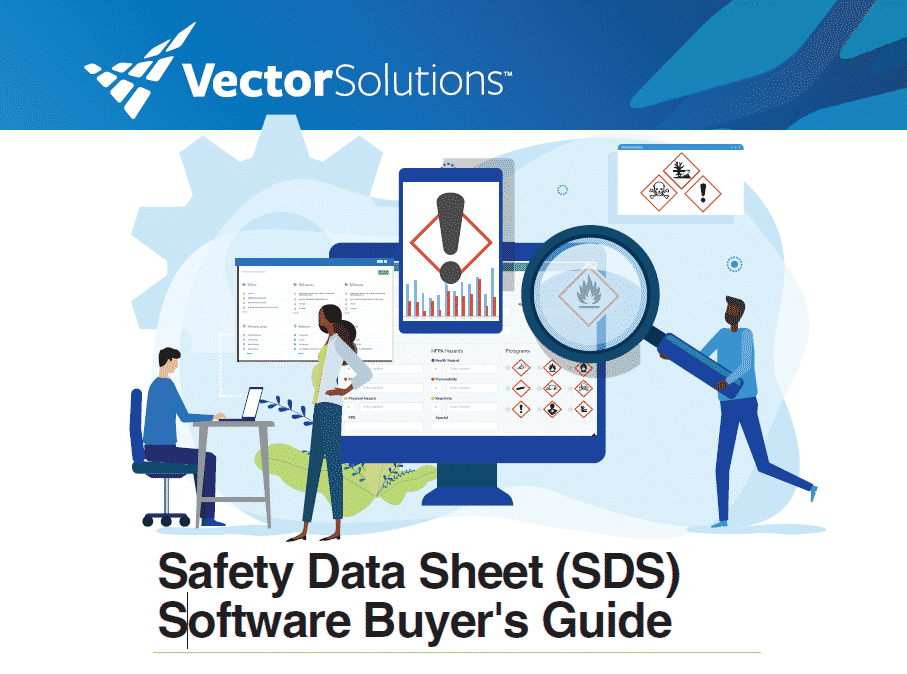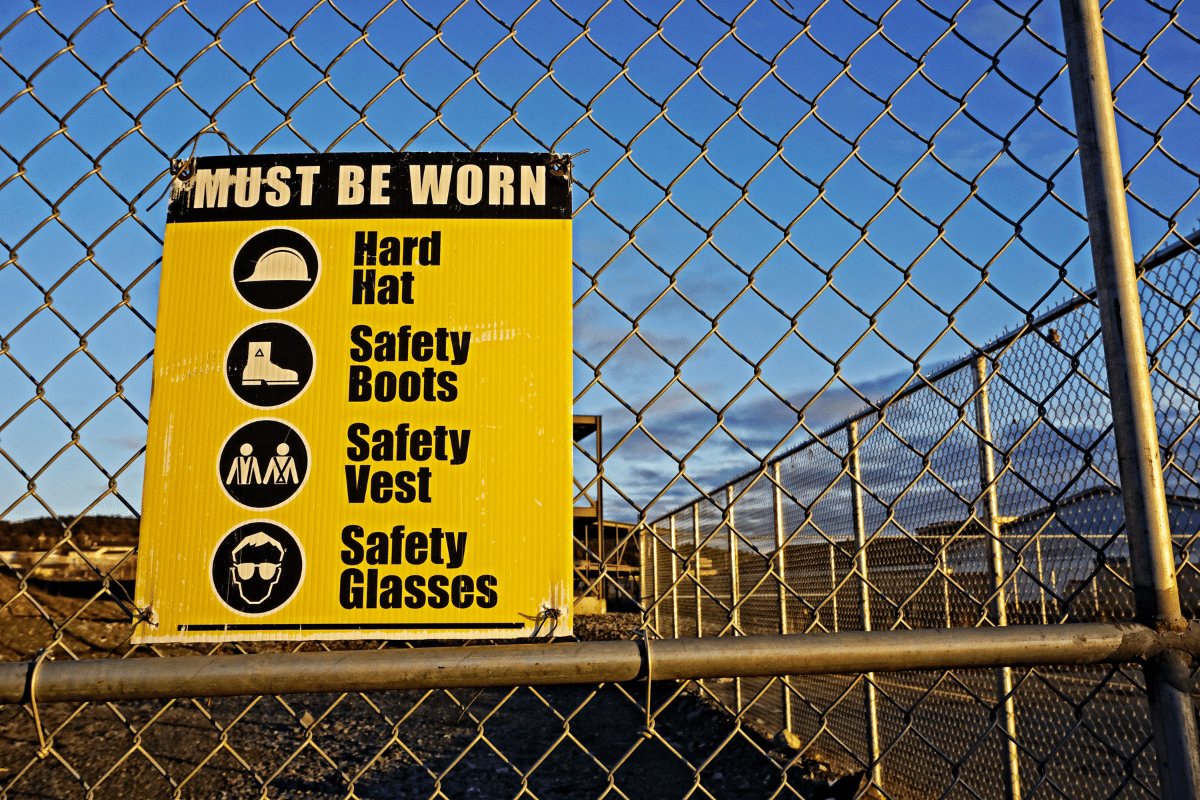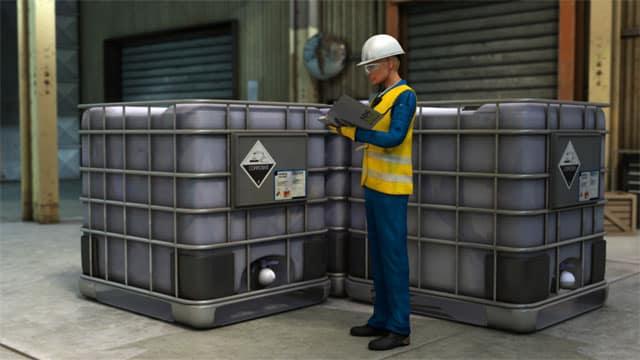October 3, 2017 9 min read
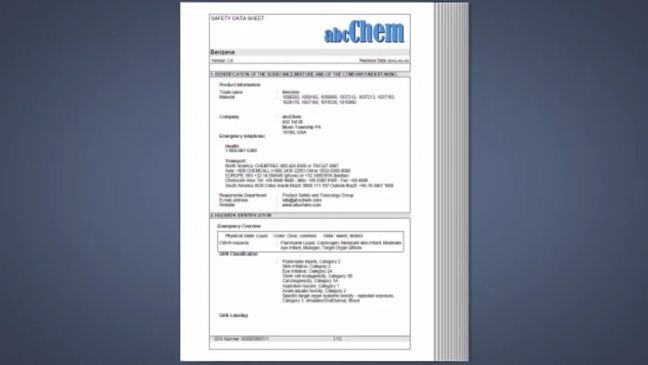
What Is a Safety Data Sheet (SDS)?
Industry:
Solution:

The safety data sheet, also known as an SDS, is an essential component of the OSHA Hazard Communication Standard and of a worker’s right to know about the chemical hazards at his or her workplace.
In this article, we’ll explain what an SDS is, how it’s related to a Material Safety Data Sheet (MSDS) and to the GHS-alignment of Haz-Com, what you’ll find in its sixteen different sections, and even give you some additional information about SDSs, including issues related to employer responsibilities and employee access.
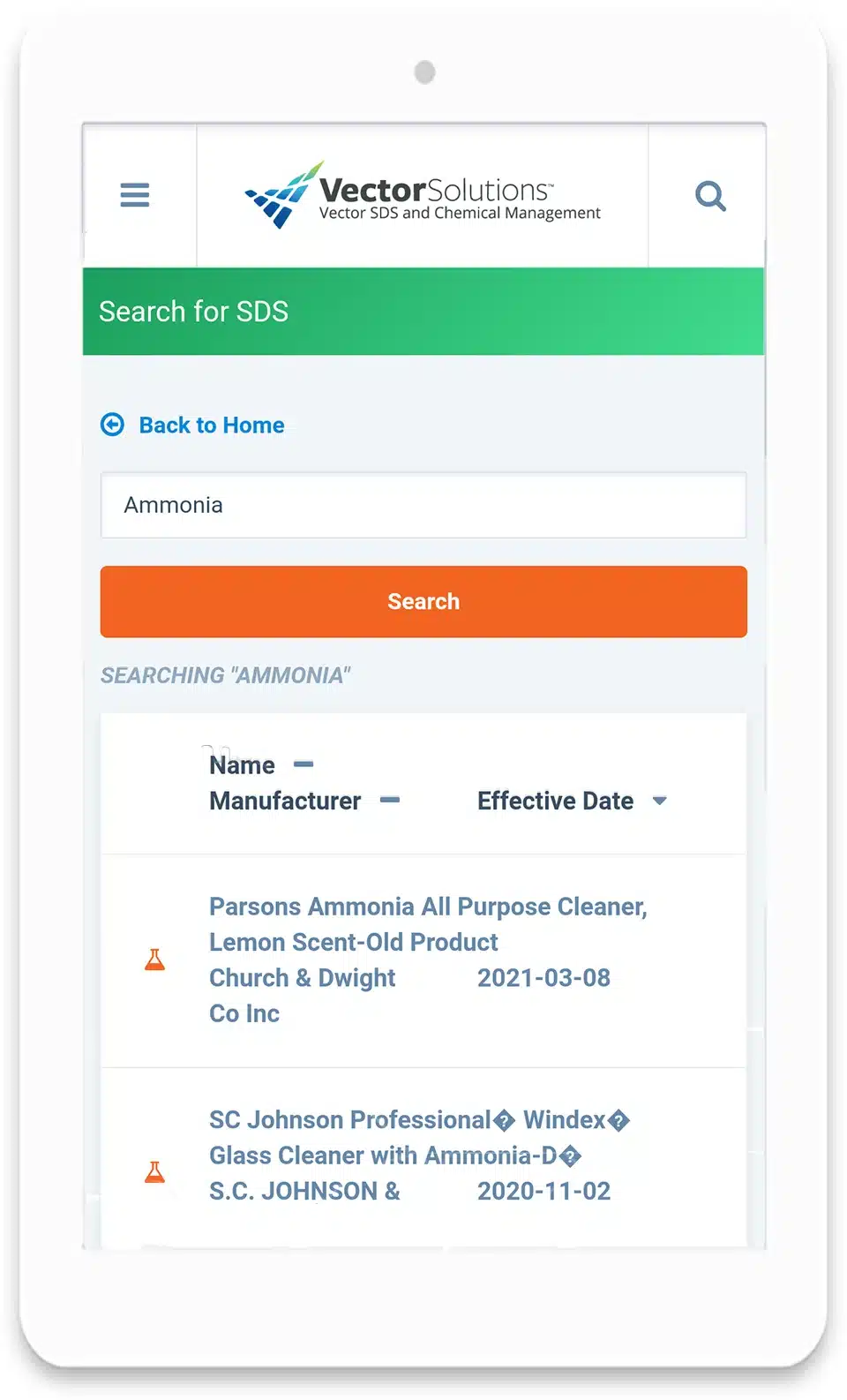
Numerous safety professionals rely on software provided by Vector Solutions to manage their SDS database, as well as record hazards and workplace incidents.
Learn more about how we can help:
Download our SDS Management Software Buyer’s Guide.
Safety Data Sheets for Hazard Communication
In 2012, OSHA changed their existing Hazard Communication, or Haz-Com, regulation, to more closely align with the Globally Harmonized System, or GHS.
As part of that change, OSHA replaced the old, pre-2012 material safety data sheets, also known as MSDSs, with the new, post-2012, GHS-aligned safety data sheets, also known as SDSs.
The primary benefit of the new safety data sheets, or SDS, is that the safety information about the hazard chemical would appear in a consistent, standard, uniform, and easy-to-understand order.
16 Sections of the Safety Data Sheet (SDS)
There are the 16 sections of the safety data sheet, or SDS.
This sample from our online Hazard Communication training course explains the different sections of an SDS.
SDS Section 1: Identification
Identifies the chemical and provides contact information of the supplier.
Must include:
- Product identifier on label and any other common names by which chemical is known
- Name, address, and phone number of the manufacturer, importer, or other responsible party, plus their emergency phone number
- Recommended use of chemical plus usage restrictions
SDS Section 2: Hazard(s) Identification
Identifies the hazard(s) of the chemical and gives appropriate warning information associated with those hazards.
Must include:
- The chemical’s hazard classification
- The signal word
- The hazard statement
- Pictograms
- Precautionary statement(s)
- Description of any hazards that are not otherwise classified (HNOC)
- (For mixtures that contain an ingredient with unknown toxicity) A statement describing what percentage of the mixture consists of the ingredient with an unknown toxicity
SDS Section 3: Composition/Information on Ingredients
Identifies ingredients in the product, including impurities and stabilizers. Includes information on substances, mixtures, and all chemicals where a trade secret is claimed.
Required information for substances, mixtures, and chemicals where are trade secret are claimed are listed below.
Substances:
Must include:
- The name of the chemical
- The chemical’s common name and any synonyms
- The chemical’s Chemical Abstracts Service (CAS) number and any other unique identifiers
- Impurities and stabilizers, which must be classified and which must contribute to the classification of the chemical
Mixtures:
Must include:
- All the same information listed above for substances
- The chemical name and concentration, expressed in terms of exact percentages, of all ingredients which are classified as health hazards and are (1) present above their cut-off/concentration limits or (2) present a health risk below the cut-off/concentration limits
- The concentration, expressed as exact percentages, of each ingredient. Alternatively, “concentration ranges” may be used (1) for trade secret claims, (2) where there is batch-to-batch variation, or (3) when the SDS is used for a group of substantially similar mixtures.
Chemicals Where Trade Secrets Are Claimed:
For chemicals where trade secrets are claimed, must include a statement that the specific chemical identity and/or concentration (expressed as an exact percentage) of composition has been withheld as a trade secret.
SDS Section 4: First-Aid Measures
Describes initial first-aid that untrained responders should provide to a person who’s been exposed to the chemical.
Must include:
- Description of most important symptoms and effects, plus any symptoms that are acute or delayed
- First aid instructions for various exposure routes (inhalation, skin contact, eye contact, ingestion)
- Recommendations for immediate medical care and special treatment, if necessary
SDS Section 5: Fire-Fighting Measures
Lists recommendations for fighting a fire the chemical causes.
Must include:
- Recommendations of appropriate fire-extinguishing equipment
- Information about fire-extinguishing equipment that is NOT appropriate for a particular situation
- Advice on specific hazards that develop from the chemical during a fire. For example, any hazardous combustion products created.
- Recommendations on special protective equipment (PPE) or precautions for fire fighters
SDS Section 6: Accidental Release Measures
Includes information on responding to spills, leaks, or releases, including containment procedures and cleanup practices. May also include recommendations that distinguish between efforts for large and small spills when spill volume has a significant impact on the hazard.
Must include:
- Recommendations for use of personal precautions and protective equipment to prevent contamination to skin, eyes, and clothes
- Emergency procedures, including instructions for evacuations, consulting experts when required, and appropriate protective clothing
- Containment methods and materials
- Cleanup procedures
SDS Section 7: Handling and Storage
Recommendations on safe handling practices and conditions for safe storage.
Must include:
- Precautions for safe handling. Must include recommendations for handling incompatible chemicals, minimizing the release of chemicals into environment, and advice on general hygiene practices (eating, drinking, and smoking in work areas)
- Recommendations on safe storage conditions, including any incompatibilities, including specific storage requirements
SDS Section 8: Exposure Controls/Personal Protection
Lists exposure limits, engineering controls, and personal protective measures that can be used to reduce worker exposure.
Must include:
- OSHA Permissible Exposure Limits (PELs), American Conference of Governmental Industrial Hygienists (ACGIH) Threshold Limit Values (TLVs), and any other exposure limit used or recommended by the chemical’s manufacturer, importer, or employer preparing the SDS.
- List of appropriate engineering controls
- Recommendations for personal protective measures to prevent harm from exposure, including PPE
- Any special requirements for PPE, protective clothing, or respirators
SDS Section 9: Physical and Chemical Properties
Lists the physical and chemical properties.
Must include:
- Appearance
- Upper and lower flammability or explosive limits
- Flash point
- Flammability (solid, gas)
- Auto ignition temperature
- Initial boiling point and boiling range
- Evaporation range
- Melting point
- Freezing point
- Odor
- Odor threshold
- Vapor pressure
- pH
- Relative density
- Solubility/solubilities
- Partition coefficient: n-octanol/water
- Decomposition temperature
- Viscosity
The SDS may omit one or more of the items listed above if it is not relevant or available. When that happens, though, a notation must be made.
In addition, manufacturers may add other relevant properties. An example would be the dust deflagration index (Kst) for combustible dust.
The SDS may not contain every item on the above list because information may not be relevant or is not available. When this occurs, a notation to that effect must be made for that chemical property. Manufacturers may also add other relevant properties, such as the dust deflagration index (Kst) for combustible dust, used to evaluate a dust’s explosive potential.
SDS Section 10: Stability and Reactivity
Describes the chemical’s stability information and reactivity hazards.
This section is broken into three smaller sections. Required information is explained below.
Reactivity:
Describes specific test data for the chemical(s). Data can be for a class or family of the chemical.
Chemical Stability:
Must include:
- Indication of whether the chemical is stable or unstable under normal ambient temperature and conditions while in storage and while being handled
- Description of any stabilizer that may be needed for chemical stability
- Indication of any safety issues that may arise should the physical appearance of the product change
Other:
Must include:
- Indication of the possibility of hazardous reactions, including a statement whether the chemical will react or polymerize, which could release excess heat or pressure, or create other hazardous conditions, as well as a description of the conditions under which hazardous reactions may occur.
- A list of all conditions that should be avoided
- A list of all classes of incompatible materials with which the chemical could react to produce a hazardous situation
- A list of any known or anticipated hazardous decomposition products that could be produced because of use, storage, or heating. These should also be listed in Section 5 of the SDS, which covers fire-fighting measures.
SDS Section 11: Toxicological Information
Lists the toxicological and health effects information, or indicates that the data is not available.
Must include:
- Likely routes of exposure, such as inhalation, ingestion, skin contact, and/or eye contact. Must also indicate if the information is unknown.
- Description of symptoms, including symptoms associated with lowest to most severe exposures
- Description of immediate, delayed, or chronic effects from short short-term and long-term exposure
- Toxicity measures in numerical terms, such as median lethal dose
- Indication of whether the chemical is listed in the the latest edition of the National Toxicology Program (NTP) Report on Carcinogens or has been found to be a potential carcinogen in the latest edition of the International Agency for Research on Cancer (IARC) Monographs or found to be a potential carcinogen by OSHA.
SDS Section 12: Ecological Information (non-mandatory)
This section is not mandatory on the SDS. It provides information to help evaluate the environmental impacts of the chemical once its released into the environment.
Information may include:
- Data from toxicity texts performed on aquatic and/or terrestrial organisms
- Whether there is a potential for the chemical to persist and degrade in the environment
- Results of tests of bioaccumulation potential, including references to Kow and BCF when possible/available
- Potential for substance to move from soil to groundwater
- Other adverse effects
SDS Section 13: Disposal Considerations (non-mandatory)
Another non-mandatory section, this one provides guidance on disposal practice, recycling or reclamation of the chemical and/or its container, and safe handling practices.
This section should also refer to Section 8 on Exposure Controls and Personal Protection.
May include:
- Description of appropriate disposal containers
- Recommended disposal methods
- Description of physical and chemical properties that may affect disposal
- Language that discourages disposal into sewage
- Any special precaution for disposing in a landfill or through incineration
SDS Section 14: Transport Information (non-mandatory)
Yet another non-mandatory section, this one lists guidance on classification information for shipping and transporting.
May include:
- UN number (the four-figure identification number)
- UN proper shipping name
- Transport hazard class or classes
- Packing group number, if applicable. This is based on the degree of the hazard.
- Environmental hazards
- Guidance on bulk transport
- Any special precautions employee should know or must comply with regarding transport and conveyance within or outside premises
SDS Section 15: Regulatory Information (non-mandatory)
And yet another non-mandatory section, this one lists any EHS regulations specific for the product not indicated elsewhere on the SDS.
May include mentions of regulations from agencies such as :
- OSHA
- Department of Transportation (DOT)
- Environmental Protection Agency
Consumer Product Safety Commission
SDS Section 16: Other Information
Indicates when the safety data sheet was prepared or when the last known revision was made. May also explain what changes were made from last version. May also include any other useful information.
More About Safety Data Sheets (SDSs)
Well, that’s a LOT of information about safety data sheets, but we’ll add a few more points below.
- They should be created by chemical manufacturers
- Employers should make sure they have a safety data sheet at the workplace for all hazardous chemicals
- Employers must allow employees to access those safety data sheets at any time during their work shift
- Safety data sheets must be accessible to workers “in the work area”
- It’s OK to keep paper-based safety data sheets or to keep them digitally on a computer
As OSHA puts it:
The employer shall maintain in the workplace copies of the required safety data sheets for each hazardous chemical, and shall ensure that they are readily accessible during each work shift to employees when they are in their work area(s).
Conclusion: Safety Data Sheets Continue a Worker’s Right to Know
Safety data sheets, also known as as SDSs, are a continuation of the OSHA Haz-Com’s regulations to guarantee an employee’s “right to know” about the chemical hazards in their workplace.
This online hazard communication training course is a good addition to your employee HazCom training program to help employees know just that.
Let us know if you have more questions about safety data sheets or the OSHA Hazard Communication regulation.
SDS Software Buyer's Guide
Download Now